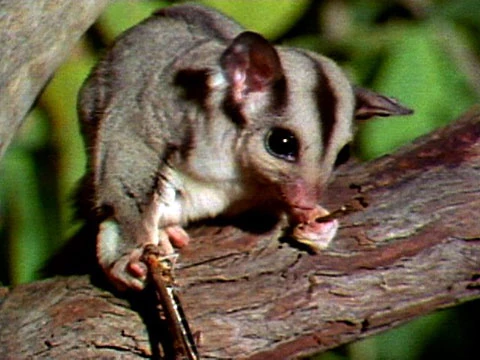Sugar Glider In The Wild
Sugar gliders are found in the wild in forests in Australia and New Guinea. They do so with about ten other adults.
 Where To See Sugar Gliders In The Wild Travelawaits
Where To See Sugar Gliders In The Wild Travelawaits
In the wild Sugar Gliders love climbing in trees so their cage should be full of ropes and ladders to encourage them to exercise this natural instinct.

Sugar glider in the wild. They are species among the Kangaroos and Koala Bears. So whether youre in Queensland New South Wales Victoria or the eastern side of the southern part of South Australia youll have a good chance at spotting some sugar gliders in the wild. Though threatened by feral animals bushfires and land clearance for agriculture sugar gliders are considered to have stable populations in the wild.
Even better have natural fixtures made from wood that replicate the kind of climbing that they would do in trees. They typically live in forests but they can be found in rural gardens and even some plantations. The sugar gliders scientific name is Petaurus breviceps which means short-headed rope dancer.
Sugar Gliders are Marsupials they originate and are from Australia. Sugar gliders are most concentrated on the eastern coast of Australia -- all the way from the northernmost tip down south to Victoria and South Australia. Sugar gliders are polygamous territorial and live in colonies of 5 to 12 individuals with a dominant male.
In other words they are not just a one person animal. They live in trees practice social grooming which does more than just keep each other clean and protect their territory that can include over two acres of land and trees. Sugar gliders are bred and kept as pets.
Sugar gliders are omnivores. Interestingly sugar gliders are pollinators and distributors of seeds. In the wild sugar gliders live communally as they nest in tree hollows.
In their natural habitat they love to consume nectar from flowers. In the wild sugar gliders live in trees and rarely if ever touch the ground. Sugar Gliders in the Wild Wild gliders live in groups of up to seven adults plus any babies that have been born recently and are highly social.
This gland extends from their forelegs to their hind legs on both sides of their body allowing them to glide upwards of 150 feet in the wild. Their fur is darker around their eyes ears legs and in a stripe down their backs. They nest in holes in old growth trees.
Its gravity-defying moves can only be appreciated by slowing them down in slow mo. In their natural wild environment they will forage for blossoms pollen nectar gum tree sap eucalyptus and acacia fruits honeydew an excretory product of nectar eating insects and they will hunt for any number of species of insects such as beetles crickets grasshoppers lerps moths worms. Gliding is an effective way for these small animals to.
Sugar gliders are marsupials pouched mammals. They are flying opossums that are small enough to fit in the palm of your hand. In the wild Sugar Gliders normally live in colonies of 10-15 other Gliders and when they begin the bonding phase of their lives approximately 9-12 weeks out of the pouch they instinctively want to bond to a whole GROUP.
Wild Sugar Gliders have brownish-grey fur large eyes long tails and a large flap of skin between their legs. Domesticated gliders may look similar to the wild type but also come in several color variations. Sugar gliders are nocturnal so.
Young sugar gliders stay with their mothers until they are between seven to. Sugar gliders are members of the Petauridae family which consists of 10 other species of possum. The sugar glider has developed a unique way to travel through the treetops.
The sugar glider is a nocturnal marsupial that is omnivorous. Their underbellies and chests are white or cream in color. Sugar gliders can be found throughout the northern and eastern parts of mainland Australia and in Tasmania Papua New Guinea and several associated isles the Bismarck Archipelago Louisiade Archipelago and certain isles of Indonesia Halmahera Islands of the North Moluccas.
Wild gliders have gray fur and a central black stripe dorsally on their heads. The sugar glider has a unique gliding membrane scientifically known as the patagium.
 Sugar Glider San Diego Zoo Animals Plants
Sugar Glider San Diego Zoo Animals Plants
 Australian Sugar Glider Youtube
Australian Sugar Glider Youtube
 Where To See Sugar Gliders In The Wild Travelawaits
Where To See Sugar Gliders In The Wild Travelawaits
 Sugar Glider Creatures Of The World Wikia Fandom
Sugar Glider Creatures Of The World Wikia Fandom
 Do Sugar Gliders Make Good Pets World Animal Protection
Do Sugar Gliders Make Good Pets World Animal Protection
Sugar Gliders In The Wild Sugar Glider Information
 Sugar Glider Fakta Makanan Dan Cara Merawatnya
Sugar Glider Fakta Makanan Dan Cara Merawatnya
 Berikut Tips Membuat Sugar Glider Jinak Dan Bonding Minews Id
Berikut Tips Membuat Sugar Glider Jinak Dan Bonding Minews Id
 Sugar Glider In The Wild Youtube
Sugar Glider In The Wild Youtube
 Sugar Glider Animal That Glides Cuteanimals
Sugar Glider Animal That Glides Cuteanimals
 Sugar Glider Facts For Kids Information With Pictures Video
Sugar Glider Facts For Kids Information With Pictures Video
 Where To See Sugar Gliders In The Wild Travelawaits
Where To See Sugar Gliders In The Wild Travelawaits
Sugar Glider Rain Forest Reports
Comments
Post a Comment